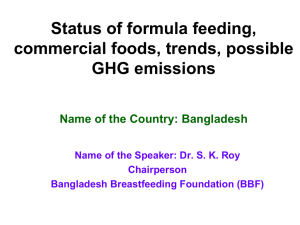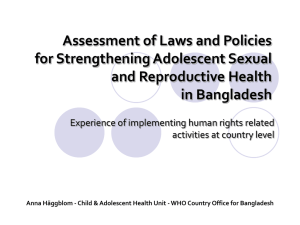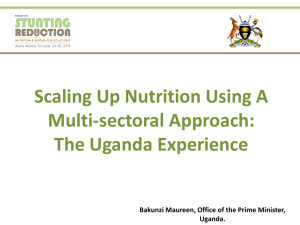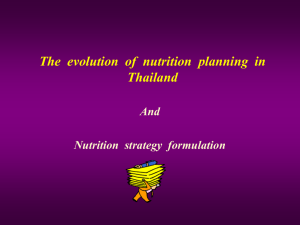Masud-nutrition-presentation
advertisement
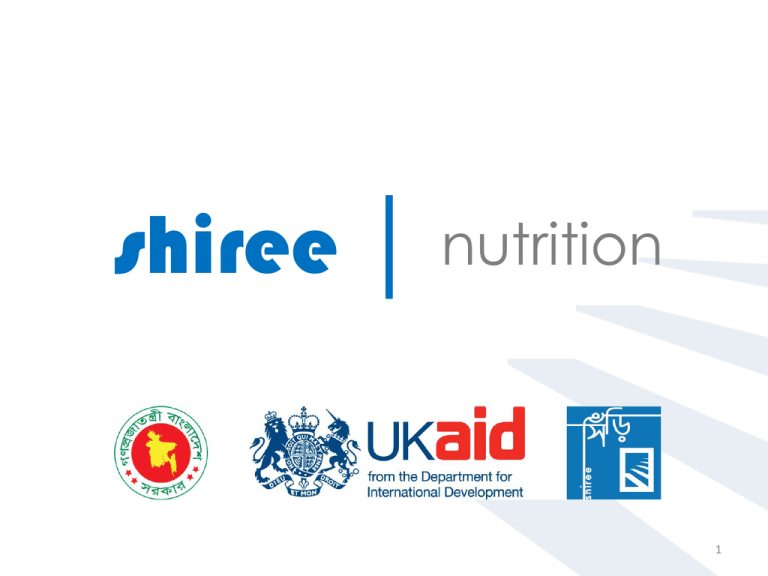
shiree │ nutrition 1 Bangladesh Demographic and Health Survey – 2011 Summary Output 23rd April 2012 2 Fertility and Family Planning Bangladesh Demographic and Health Survey – 2011 3 Trends in Fertility Total Fertility Rate (Births per woman) 2016 Aim: 2.0 7 6.3 6 5.1 5 4.3 4 3.4 3.3 3.3 3 3 2.7 2.3 2 1 0 BFS 1975 BFS 1989 CPS 1991 BDHS 93-94 BDHS 96-97 BDHS 99-00 BDHS 2004 BDHS 2007 BDHS 2011 4 Trends in Use of Contraception Percentages of married women age 15-49 currently using a methods of family planning 2016 Aim: 72 70 60 50 54 45 58 61 56 49 40 30 20 10 0 BDHS 93-94 BDHS 96-97 BDHS 99-00 BDHS 2004 BDHS 2007 BDHS 2011 5 Unmet Need for Family Planning Percentages of married women age 15-49 who wish to spare or limit births but are not using contraception 16 Sylhet 8 Rangpur 9 Rajshahi 8 Khulna 11 Dhaka 19 Chittagong 10 Barishal 0 5 10 2016 Aim: 9% 15 20 6 Maternal Health Bangladesh Demographic and Health Survey – 2011 7 BDHS 2004 BDHS 2007 35 2016 Aim: 50% for all three indicators 32 30 27 26 25 20 BDHS 2011 22 17 21 20 16 16 15 10 5 0 Source: BDHS 2011 ANC at least 4 visits Delivery attended by a medically trained provider PNC for mothers within 2 days of delivery from a medically trained provider Trends in Maternal Health Among births three years before the survey 8 Trends in Delivery in Health Facilities by Wealth Percentages of births delivered in health facilities in the three years before the survey Lowest Wealth Quintile Highest Wealth Quintile 70 60 60 49 50 2016 Aim: <1:4 for percentage of deliveries of deliveries in health facilities among the poorest and wealthiest women 38 40 30 20 10 3 0 6 10 9 Child Survival and Health Bangladesh Demographic and Health Survey – 2011 10 Trends in Child Mortality Neonatal Mortality 140 133 2016 Aim: 21 Infant Mortality under-five Mortality 2016 Aim: 31 2016 Aim: 48 116 120 Deaths per 1,000 live births 94 100 87 88 82 80 66 60 52 65 65 52 48 42 41 40 37 53 42 32 20 0 1989-93 1992-96 1995-99 1999-2003 2002-06 2007-11 11 Childhood Care Percent of children under age five 100 2016 Aim: 90% 2016 Aim: 50% 2016 Aim: 90% 90 80 88 70 71 60 62 50 40 30 20 10 0 Measles Vaccine Source: BDHS 2011 ARI Treatment with Antibiotics Vitamin A Supplemintation 12 Nutrition Bangladesh Demographic and Health Survey – 2011 13 Trends in Exclusive Breastfeeding Percent of children under 6 months who are exclusively breastfeed 2016 Aim: 50% 70 64 60 50 46 45 46 BDHS 93-94 BDHS 96-97 BDHS 99-00 42 43 BDHS 2004 BDHS 2007 40 30 20 10 0 Source: BDHS 2011 BDHS 2011 14 Trends in Vitamin A Supplementation Percent of children age 9-59 months receiving Vitamin A supplementation in the six months preceding the survey 2016 Aim: 90% 90 80 82 88 80 62 70 60 50 40 30 20 10 0 BDHS 99-00 Source: BDHS 2011 BDHS 2004 BDHS 2007 BDHS 2011 15 IYCF Practices Percent of children age 6-23 months Fed with all 3 IYCF practices Not fed with all IYCF practices 100 90 80 70 60 79 85 79 21 15 21 50 40 30 20 10 0 Breastfed Source: BDHS 2011 Non-breastfed All 6-23 months 2016 Aim: 52% 16 Trends in Children’s Nutritional Status Percent of children under age five BDHS 2004 2016 Aim: 38% 60 50 51 53 41 BDHS 2007 BDHS 2011 WHO threshold for 'very high‘ prevalence of underweight (30%) WHO threshold for 'very high‘ prevalence of stunting (40%) 43 41 36 40 30 20 10 0 Stunting (height for age) Source: BDHS 2011 Underweight (weight for age) 17 Nutrition Status at shiree shiree Change Monitoring System (CMS) - 3 18 Stunting, wasting and underweight amongst under 5s (shiree BHH) with data CMS3 surveys Stunting 60 52.2 Underweight WHO threshold for 'very high‘ prevalence of stunting (40%) WHO threshold for 'very high‘ prevalence of underweight (30%) 50.8 48 50 Wasted 50 46.1 WHO threshold for 'very high‘ prevalence of wasting (15%) 47.1 41 40 36 30 23.7 22.5 23.5 20 16 10 0 shiree 2009 shiree 2010 shiree 2011 BDHS 2011 19 Adult nutrition status of shiree beneficiaries BMI <18.5 58.5 60 53.1 51.2 50 40 30 Anaemic 56.2 51.5 49 47 46.3 35 52.2 45.1 33.3 WHO threshold for 'very high‘ prevalence of CED (BMI<18.5 is 40%) WHO threshold for Severe public health problem (Adult anaemia = 40.0 %) 20 WHO threshold for 'high‘ prevalence of CED (BMI<18.5 is 20%) 10 0 Mar-10 Mar-11 Male Mar-10 Mar-11 Female Mar-10 Mar-11 Total 20 Why Nutrition is important? Foundation to development contributing to MDG’s Economic benefit Low Birth Weight (LBW) perpetuates intergenerational cycle of undernutrition and disease Economic growth – unlikely to yield Nutrition results 21 Nutrition’s Impact on Poverty 20% of the world’s deaths and disabilities are due to undernutrition. Loss of GDP from undernutrition can be as high as 3% (year in, year out). Better nutrition empowers people and communities through: •improved intellectual capacity •income generation and access to assets •poverty reduction; and •rapid development 22 Modified from WB,2004 Income Poverty Low Food Intake Frequent Infections Hard physical labour Frequent pregnancies Large families Malnutrition Direct lossloss in in Direct productivity form productivity poorfrom physical poor status physical status Indirect Indirect loss inloss in productivityfrom frompoor poor productivity cognitive development cognitive development and schooling and schooling Loss resources Loss inin resources from increased from increased healthcare carecosts costsof of health ill-health ill-health 23 Nutrition contribution to MDGs MDG Nutrition is a foundation for MDGs. It help to achieve: Goal 1: Eradicate extreme poverty and Improved cognitive and physical development, and hunger. income earning potential Goal 2: Achieve universal primary education. Good nutrition improves school attendance and performance Goal 3: Promote gender equality and empower women. Empowering women in society improves their own and children’s nutrition. Goal 4: Reduce child mortality. Prevention of child deaths caused directly or indirectly by undernutrition Goal 5: Improve maternal health. Prevention of undernutrition will improve maternal health and lower the risk of maternal mortality. Goal 6: Combat HIV/AIDS, malaria, and other diseases. Reduced risk of HIV transmission, onset of fullblown AIDS and premature death. Reduced risk of TB infection resulting in disease, and improved malarial survival rates. 24 Economic Benefit 2-3 % GDP lost as a result of undernutrition – most developing countries including Bangladesh >10% reduction in life time earning of each malnourished individual Bangladesh – loses over USD700 million in vitamin and mineral deficiencies Scaling up core micronutrient interventions cost less than US$65 million per year 25 Figure : GDP Loss Due To Iron Deficiency Source: Horton 1999, web-link: http://www.unscn.org/files/Publications/Briefs_on_Nutrition/Brief8_EN.pdf 26 What are the causes of Malnutrition then? 27 Long-term consequences: Adult size, Intellectual ability, Economic productivity, Reproductive performance, Metabolic and cardiovascular diseases Short-term consequences: Mortality, Morbidity, Disability Maternal and child undernutrition Inadequate dietary intake Household food insecurity Underlying Cause Immediate Cause Disease Inadequate care Unhealthy household environment and lack of health services Income poverty: employment, self-employment, dwelling, assets, remittances, pensions, transfers etc. Lack of capital: financial, human, physical, social, and natural Basic Cause Social economic and political context 28 When should we intervene? The “Window of Opportunity” for Improving Nutrition is very small …pregnancy until 18-24 months of age Beyond two years stunting is largely irreversible 29 Window of Opportunity” for Improving Nutrition 0.50 Weight for age Z-score (NCHS) 0.25 Latin America and Caribbean 0.00 Africa Asia -0.25 -0.50 -0.75 -1.00 -1.25 -1.50 -1.75 -2.00 0 3 6 9 12 15 18 21 24 27 30 33 36 39 42 45 48 51 54 57 60 Age (m onths) 30 key interventions 31 Determinants of Child Nutrition and Interventions to Address them Nutrition specific interventions Interventions - Infant and young child nutrition and treatment of severe undernutrition - Micronutrient supplementation & fortification - Hygiene practices - Agriculture & food security - Health Systems - Soc. Protection/safety nets - Water & sanitation - Gender & Development - Girls’ Education -Climate change - Poverty reduction & economic growth programs -Governance, stewardship capacities & management -Trade & patents (&role of private sector) - Conflict Resolution Food/nutrient intake Access to food Health Maternal and childcare practices Water/ Sanitation Health services Immediate causes R O U T E S Underlying causes L O N G INSTITUTIONS POLITICAL & IDEOLOGICAL FRAMEWORK S H O R T Basic causes ECONOMIC STRUCTURE Nutrition 32 sensitive R O U T E S Shiree nutrition intervention 1. Scale up proven intervention 2. Innovation Fund 3. Research and Monitoring 4. Advocacy 33 SF Target Groups: 1. 2. 3. 4. 5. Pregnant women Breastfeeding women Children < 2 years Children 2-5 years Adolescent girls 6. All family members (deworming only !) 34 Major Scale Fund Interventions: Behavior change interventions (Individual counselling and group meetings) 1. Breastfeeding promotion and support a. Early initiation of breastfeeding b. Exclusive breastfeeding for six months and continued breastfeeding until two years of age 2. Complementary feeding promotion a. Behavior change promotion to follow international best practices Proven Interventions 3. Handwashing with soap and promotion of hygiene behaviors a. Delivery of educational messages Micronutrient and deworming interventions 1. Multiple micronutrient supplements (MNS - 5 components) 2. Deworming (Albendazole Tablets and suspensions) 35 3. Iron-folic acid supplements (IFA tablets) Expected results 1. An improvement in adolescent and maternal nutritional status as defined by changes in weight (and concomitant body mass index) and haemoglobin concentration 2. An improvement in child growth (i.e. reduction of stunting, wasting and underweight infants and young children) and improvement in haemoglobin concentration 3. Beneficiaries are better placed to sustainably transition out of extreme poverty 36 Counselling Pregnant mothers Breastfeedi ng mothers Adolescent girls Infants 6 to 23 mo’ Children 12 mo’ to 5 yrs Others IFA MNP Deworming Social Mobilisation Through Group meeting and Social mobilisation sessons 1. All target groups 2. Adolescent girls 3. Religious leaders 4. Village doctors & TBAs 5. School teachers & Local Govt. Only family members - At the beginning 6. Local influentials 37 Activity Details – Individual counselling Step 1: survey community and list eligible shiree beneficiary households Step 2: Allocation of responsibility to community volunteers Step 3: Hands on training Step 4: Supportive Supervision Step 5: Monthly meetings Step 6: Performance Incentives Step 7: Accountability, Monitoring, Learning and Evaluation 38 Social Mobisation Mass media Campaign Video show; Tea stall 1. Listing all PW to 24m in catchment area V Doc, Religious Leaders, Adolescents, TBAs, School Teachers 2. Allocate Staff, volunteers of 1 (CPKs/V): 20 and 1 (sup): 10 ratios 7. Monitoring for data based decision Central Coordination, Management, Exchange Lessons 6. Reward, recognition, or performance based incentives 5. Monthly review, feedback, microplanning 3. Basic Hands on Training 4. Observed supervisional support Supply IFA Tab; Deworming drugs; MNS 39 Approved Drug Regimen by Target Group Category of Clients Pregnant women De-worming Iron & Folic Acid (IFA) 180 tablets per 1 tablet of 400 mg per woman/year (each women/year after the tablet contains 60 mg first trimester iron and 400 microgram folic acid) Micronutrient Supplément (MNS)- 5 components. Remarks Deworming will be given after first trimester. IFA will be given as soon as pregnancy is detected maximum 180 tablets. Breastfeeding women 90 tablets per woman/year (each tablet contains 60 mg iron and 400 microgram folic acid) For 3 months post partum. Adolescent girls (10 - 16 years of age). 2 tablets/week (each tablet contains 60 mg iron and 400 mcg folic acid) total 104 tablets/year. IFA once a week and deworming twice a year. 2 tablets of 400 mg per girls/year 40 Approved Drug Regimen by Target Group Category of Clients De-worming (IFA) Micronutrient Supplément -5 components. Remarks Children aged between 7 - 12 months 1 sachests / day for 60 day Children aged between 13 - 18 months 2 vial (suspension) of 200 mgs per child/year 12 months is the minimum age at 1 sachests / day which children can for 60 day receive deworming treatment. Children aged between 19 - 23 months 2 vial (suspension) of 200 mgs per child/year 1 sachests / day for 60 day Children aged between 24-59 months 2 tablets of 400 mg per child/year Other family members 1 tablets of 400 mg per person/year 41 Training Materials 42 BCC Materials 1.Job aid 2.Training Manuals 3.Social Mobilisation Brochure 4.Social Mobilisation Manual, FlipChart 5.Brochure for Adolescent Girls 6.Advocacy brochure 7.Observation Checklist and Social Mobilization Guidelines 8.Illustrated comic books on maternal and child nutrition for adolescent groups 9.DVDs on IYCF TVCs, RDCs and Meena film 43 1. Technical support & consultation will be provided by A&T (Alive and Thrive) 2. Existing training materials developed by A&T on IYCF and micronutrient supplementation will be used 3. Modules for group meetings will be reviewed and adopted – shiree partners and A&T 4. Master trainers will be trained by A&T 44 Logistics 45 Procurement & Supply 1. Procurement of IFA for pregnant women and adolescent girls 2. Procurement of MNPs for children under 2 3. Procurement of deworming drugs for children and other family members will be centrally procured and distributed to the SF NGOs 46 Target group Pregnant women (3% of total population) Breastfeeding women (7.33 % of total population) Children < 2 years(6.67% of total population) Children 2-5 years(15.33% of total population) Adolescents (14.29% of total population) All family members(assuming a family number of 3.48 /households) Total 2012-13 2013-14 2014-15 Total (82850 BHHs) (215500 BHHs) (215500 BHHs) 8650 22500 22500 53,650 21000 55000 55000 131,000 19,000 50,000 50,000 119,000 45,000 115,000 115,000 275,000 41,000 107,135 107,135 255,270 331400 862000 862000 2,055,400 466,050 1,211,635 1,211,635 2,889,320 Forecasted numbers of beneficiaries 2012-2015 47 Monitoring & Evaluation 48 Used for: 1. Reporting to Donor and GoB • Progress against log-frame • Achievements of quarterly/monthly targets 2. Programme Management • Track the changes • Feeding back to the implementing partners 3. Exchange and sharing with other stakeholders 49 Impact Indicators 1. % point of targeted U-2 children: stunted underweight wasted anaemic. 2. % point of targeted pregnant and breastfeeding mothers and adolescent girls: chronic energy deficient (CED) anaemic 50 Outcome Indicators 1. % of targeted mothers of infants 0-6 months exclusively breastfeeding (as per WHO definition) 2. % of targeted mothers of children 7-23 months practicing appropriate complementary feeding (as per WHO definition) 3. % of targeted U-2 children (7-23 months) consuming Micronutrient Supplement (MNS) and 95% children 12-24 months consuming antehelmintics (deworming) 4. % of targeted pregnant and breastfeeding women consuming iron and folic acid 5. % of targeted pregnant women consuming antehelmintics (de-worming tablets) 6. % of targeted adolescent girls consuming iron and folic acid and antehelmintics 7. % reduction in diarrhoea among targeted children < 5 years 51 of age over a 30 day period Reporting Frequency: 1. Monthly monitoring report 2. Programme report 3. Financial report Tools : 1. 2. 3. 4. Change Monitoring System Internal monitoring and MIS Community Pusti Karmi’s register Observation Checklist – visitors (?) 52 Key things to focus on: 1.Availability of suitably qualified people, especially in remote areas. 2.Getting community support and involvement for the intervention; 3.Target groups are not affected by significant shocks e.g. high food price inflation or disasters; 4. Identification of target groups- Pregnant 53 Key things to focus on: 5. Behavioural Change Communication (BCC) provided by trained nutrition consellors •Regular visit •Supportive supervision •Monthly meeting 6. Micronutrient supplements and deworming tables: •Logistical arrangements, •Timely distribution and •Consumption 54 Strengthening Indirect responses: 1. Social transfers and other social protection measures 2. Food security and agricultural interventions • Homestead food production 3. Primary and maternal and child health care – Linkages to existing health services 4. Clean and safe drinking water and improved sanitation and hygiene 5. Education, especially girls’ education 6. Women’s empowerment 55 Rates of severe stunting, by availability or non-availability of public intervention in village of residence, 2000 Not available 35 31 31 20 25 23 21 31 29 30 25 Available 19 19 19 22 23 19 20 20 20 15 10 5 0 Entire sample Poorest quintile Entire sample Poorest quintile Entire sample Poorest quintile Entire sample Poorest quintile Food-for-Work Program Vulnerable Group Feeding Program Vulnerable Group Development Program Grameen Bank or BRAC 56 Source: siteresources.worldbank.org/.../PA2+Child+Nutrition+-+Oct02.ppt Theory of Change Direct interventions Breast feeding promotion and support Complementary feeding promotion Promotion of hygienic behaviour Micronutrients Deworming Indirect interventions Asset transfer (livestock, poultry etc.) Cash transfer Income generating activities Homestead gardening Community mobilisation and activities to promote women empowerment Project Inputs Linkage with health and education services and government safety next programmes shiree (EEP) internal monitoring and evaluation Strengthen Monitoring and Evaluation Promoting innovation Testing mechanisms to increase access to high protein diet 1. Improved Infant and child feeding practices 2. Improved hygiene 3. Improved parasite control Improved diet and increased food diversity Baseline data collected/established Data collection and analysis every month Undertake operational research providing feedback on delivery service, systems and compliance Increased understanding on importance of animal protein diet Increased demand of high protein diet Reduced micronutrient deficiency Reduced disease burden Reduced anaemia 6 monthly reports published Evidence shared to Partners and DFID Nutrition Lessons learned informed programme amendments Improved delivery service Reduced maternal and child undernutrition Increased animal protein diet Evidence of how to increase protein in the diet Evidence shared and rolled out in extreme poverty programmes 57 Additional Staff for implementation: 1. Technical Coordinator: Nutrition – 1/ SF NGO 2. Nutrition Officer – 1 / SF NGO 3. Master Trainer – 2 / SF NGO 4. Community Pusti Karmis – Female counsellors (based on requirement) 58 NEXT: 1. Shiree agreement with DFID 2. Contract amendment with SF partners 3. Recruitment of technical staff and female counsellors (CPKs) 4. Finalising NGO operational plan, including logistics 5. Training planning and conduction 6. Ensuring effective M&E and MIS – using existing M&E 7. Roll out the intervention 59 THANKS 60 61
